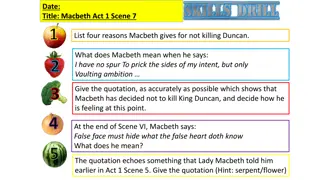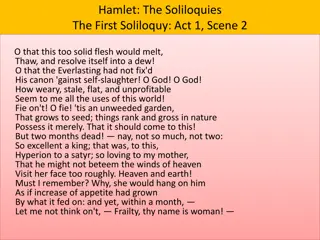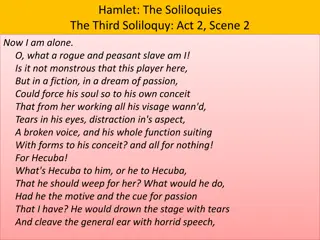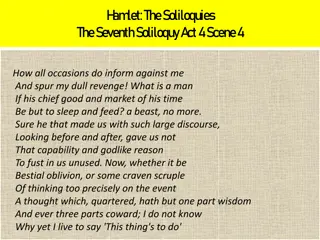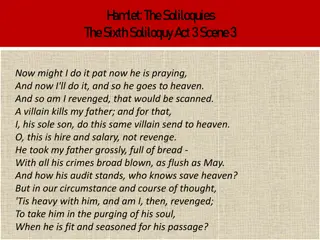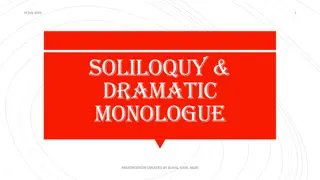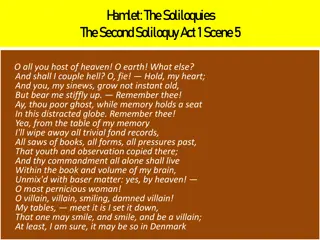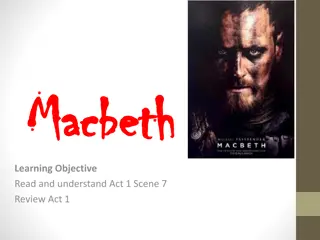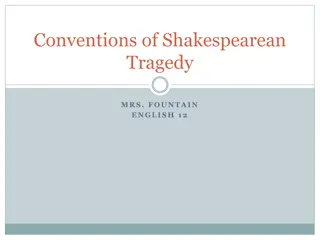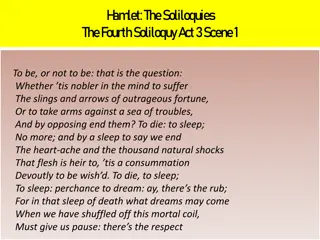Macbeth's Internal Struggle: To Kill or Not to Kill
In Act 1, Scene 7 of Shakespeare's "Macbeth," Macbeth grapples with the decision of whether to assassinate King Duncan. He considers the consequences, his loyalty to Duncan, the king's virtuous nature, and the only driving force being his ambition. Macbeth struggles with his vaulting ambition and ul
8 views • 10 slides
Analysis of Hamlet's First Soliloquy in Act 1, Scene 2
The first soliloquy in Shakespeare's "Hamlet" captures the protagonist's deep melancholy and internal turmoil following his father's death and his mother's hasty marriage to his uncle. Hamlet expresses suicidal thoughts, seeing life as futile and the world as a corrupted place. This soliloquy sets t
0 views • 7 slides
Hamlet: The Third Soliloquy from Act 2, Scene 2
Hamlet contemplates his own indecision and lack of action in seeking revenge for his father's murder. He questions the player's ability to feel deeply for a fictional character and expresses his frustration at his own inaction. Through introspection, he resolves to use a play to uncover the truth an
0 views • 10 slides
Hamlet's Seventh Soliloquy: Reflections on Revenge and Inaction
Prince Hamlet reflects on the nature of revenge, his own inaction, and the contrast between his hesitation and the willingness of soldiers to die for trivial causes, ultimately resolving to be resolute and decisive in seeking retribution.
1 views • 9 slides
Analysis of Hamlet's Sixth Soliloquy in Act 3, Scene 3
Hamlet's Sixth Soliloquy in Act 3, Scene 3 delves into his inner turmoil as he contemplates seeking revenge on Claudius for his father's murder. Despite having the perfect opportunity to kill Claudius while he prays, Hamlet hesitates, questioning whether sending him to heaven would truly be an act o
0 views • 7 slides
Understanding Soliloquy and Dramatic Monologue in Literature
A soliloquy is a form of monologue where a character speaks to themselves, the audience, or a surrogate, revealing inner thoughts. This presentation explores different types of soliloquies and their significance in literary works, including examples from Shakespeare's Hamlet. Additionally, it delves
0 views • 9 slides
Hamlet's Second Soliloquy: The Revelation and Vow for Revenge
Hamlet's second soliloquy in Act 1, Scene 5, follows the shocking revelation from his father's ghost that Claudius is the true murderer. Filled with grief and anger, Hamlet vows to avenge his father's death, referring to his mother as a "pernicious woman" and his uncle as a "smiling damned villain."
0 views • 5 slides
Exploring Shakespeare's Richard III and the Possibility of Hyper-Machiavellianism
Shakespeare's play Richard III delves into the complex character of Richard Gloucester, questioning the limits of Machiavellian tactics in the ruthless pursuit of power. The soliloquy reveals Richard's ability to manipulate emotions, deceive, and scheme without remorse, showcasing his willingness to
0 views • 15 slides
Examining Literary Devices in Romeo and Juliet
This review explores key literary devices such as dramatic irony, situational irony, verbal irony, iambic pentameter, simile, metaphor, personification, imagery, and soliloquy in Shakespeare's Romeo and Juliet. Examples from the play illustrate how these devices enhance storytelling and character de
0 views • 17 slides
Analyzing Macbeth's Internal Struggle in Act 1 Scene 7
Explore Macbeth's inner turmoil and conflicting emotions as he contemplates the idea of killing King Duncan in Act 1 Scene 7 of Shakespeare's play. From his soliloquy to the shocking imagery, delve into the complexities of Macbeth's character and the impact of ambition on his psyche.
0 views • 10 slides
Exploring Shakespearean Tragedy: Conventions and Characteristics
Delve into the world of Shakespearean tragedy through the examination of key conventions such as the tragic hero, plot development, and themes. Understand the aspects of tragedy and drama, including blank verse, soliloquy, aside, dramatic irony, and foreshadowing. Discover how these elements come to
0 views • 10 slides
Reflections on Life and Death in Hamlet's Soliloquies
Hamlet's fourth soliloquy in Act 3, Scene 1 delves deep into the contemplation of life, death, and the eternal question of existence. Through introspective discussion, Hamlet ponders the choices of enduring hardships or taking action to end suffering. The soliloquy captures the essence of human mort
0 views • 9 slides
